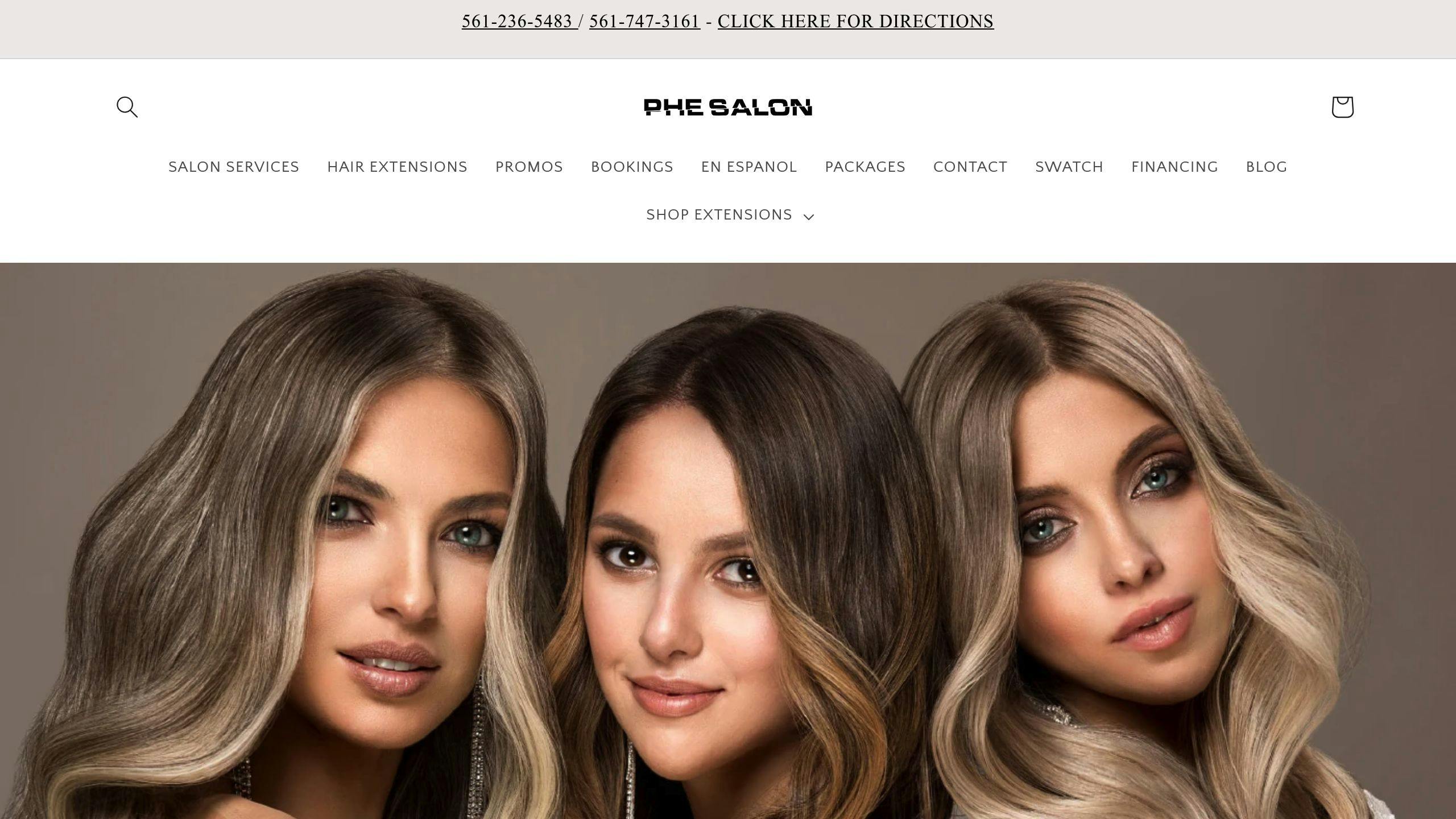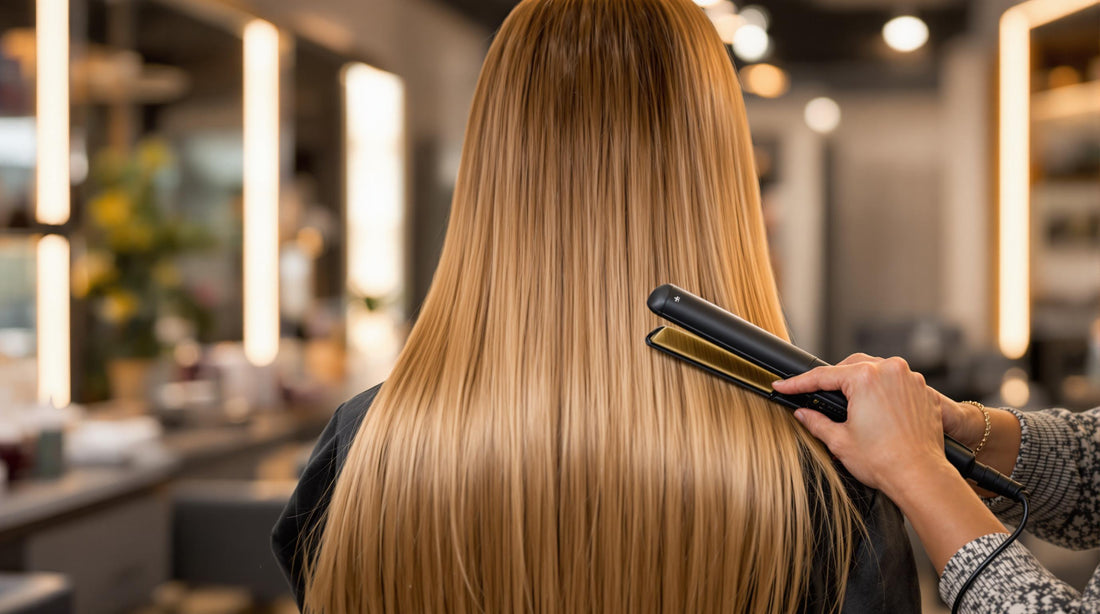Straightening human hair extensions is all about preparation, technique, and care. Here’s what you need to know to get sleek, damage-free results:
- Use High-Quality Extensions: Choose Remy or virgin human hair for durability and better heat resistance.
- Temperature Control: Stick to 250°F–350°F (120°C–180°C) for safe straightening. Avoid exceeding 190°F (88°C) for delicate extensions.
- Heat Protectant: Always apply a heat protectant to shield extensions from damage.
- Preparation Steps: Wash, condition, detangle, dry thoroughly, and section the extensions before straightening.
- Maintenance: Schedule professional adjustments every 4–6 weeks, use lightweight serums, and avoid excessive heat.
Pro Tip: Work in small sections, use even heat, and prioritize gentle handling to maintain the longevity and shine of your extensions. For the best results, consider professional care at a salon like PHE Salon in Jupiter, Florida.
This guide covers everything from prepping your extensions to fixing common issues like frizz and tangling. Let’s dive in!
How to Prepare Hair Extensions for Straightening
Choosing the Best Hair Extensions
Opt for Remy or virgin human hair extensions. These types are known for their durability and natural look, plus they handle heat styling better than synthetic options [1]. They also have a natural protective layer that helps shield against heat damage [2].
Preparing Extensions for Straightening
Getting your extensions ready is a must to protect them and achieve smooth, sleek results. Here’s how to do it:
- Wash and Condition: Use a gentle shampoo with lukewarm water. Follow up with a deep conditioner to keep the extensions hydrated [2].
- Detangle Carefully: Use a wide-tooth comb, starting from the ends and working your way up. This prevents breakage and ensures heat is distributed evenly when straightening [3].
- Dry Thoroughly: Let your extensions air dry, or use a blow dryer on a low-heat setting if you're in a hurry. Make sure they’re completely dry before moving on to heat styling.
- Apply Heat Protectant: Coat the extensions evenly with a heat protectant spray to reduce the risk of damage [4].
- Section for Straightening: Clip the extensions into smaller sections. This makes the straightening process easier and ensures each strand gets the attention it needs [4].
Professionals at PHE Salon in Jupiter, Florida, emphasize the importance of drying extensions entirely before using any heat tools to avoid unnecessary damage.
Straightening Human Hair Extensions: Step-by-Step
Straightening Extensions While Attached
To straighten extensions while they're attached, divide your hair into 4-6 sections. Work in small subsections to ensure even heat application. Here's how to do it:
- Support the base: Hold the attachment point with one hand to avoid pulling or stressing the bonds.
- Straighten from roots to ends: Move the straightener slowly and steadily down the hair.
- Apply gentle pressure: Use consistent, light pressure to protect the bonds from heat damage.
"To straighten attached extensions, start by gently brushing the hair to remove any kinks or knots. Then, apply a heat protectant, focusing on the length of the hair rather than the roots" [1].
Straightening Extensions Before Applying Them
If you prefer to straighten extensions before putting them in, secure them properly first. Use a hanger or holder to keep them in place. Work in 2-inch sections, straightening with slow and controlled movements for the best results.
Setting the Right Temperature for Straightening
The temperature you use is crucial. Stick to 160-190°F (71-88°C) and adjust based on the condition and quality of your extensions. High-quality human hair extensions, like those from PHE Salon in Jupiter, Florida, respond well to careful heat application.
Temperature tips:
- Start with the lowest effective temperature.
- Test on a small section before styling the entire set.
- Avoid going above 190°F (88°C) to prevent damage.
"Using higher temperatures can cause permanent damage to both the extensions and the natural hair. It is crucial to use low to medium heat to ensure the longevity and health of the hair extensions" [2][3].
Once straightened, take good care of your extensions to keep them looking smooth and lasting longer.
How to Care for Straightened Hair Extensions
Using Heat Protectants and Moisturizers
After straightening, apply lightweight serums or argan oil to keep your extensions hydrated and smooth. Always use a heat protectant before any future styling to shield the hair from damage. Focus on the mid-lengths and ends, steering clear of the bonds, to maintain a polished look.
Scheduling Maintenance and Reapplication
Regular visits to your stylist every 4-6 weeks are essential for adjusting and securing the bonds. This helps keep your extensions in place and prevents damage caused by overgrowth. Consistent care keeps your extensions looking sleek and ensures they stay in good condition.
| Maintenance Task | Purpose | Frequency |
|---|---|---|
| Move-up appointments | Adjust and secure bonds | Every 4-6 weeks |
| Deep conditioning | Restore moisture | Weekly |
| Professional assessment | Check extension health | Monthly |
Limiting Heat and Styling Damage
When straightening is needed, keep your flat iron temperature below 200°F (93°C). Use a wide-tooth comb or a brush designed for extensions to gently detangle without putting stress on the bonds.
"Using higher temperatures can cause permanent damage to both the extensions and the natural hair. It is crucial to use low to medium heat to ensure the longevity and health of the hair extensions" [2][3].
To further protect your extensions:
- Loosely braid them before going to bed.
- Sleep on silk or satin pillowcases to reduce friction.
- Apply hydrating treatments weekly.
PHE Salon in Jupiter, Florida, specializes in rehydration treatments and other services that help prolong the life of straightened extensions. With consistent care, your extensions can stay smooth and damage-free. However, occasional issues like frizz or tangling may still occur - here’s how to handle them.
Common Problems When Straightening Extensions and How to Fix Them
Mistakes to Avoid When Straightening Extensions
Using too much heat, skipping heat protectants, neglecting proper sectioning, or not detangling correctly can all damage your extensions. These mistakes often result in frizz, brittleness, or uneven results. To avoid this, always use a flat iron with precise temperature settings and start with a lower heat level to keep your extensions safe [2].
| Common Mistake | Impact | Solution |
|---|---|---|
| Excessive heat (>350°F) | Brittleness, damage | Keep temperature below 200°F (93°C) |
| Skipping heat protectant | Frizz, dryness | Always apply a heat protectant |
| Poor sectioning | Uneven straightening | Work in small 1-inch sections |
| Improper detangling | Matting, breakage | Use a brush designed for extensions |
For example, poor sectioning often causes uneven results and increases the risk of damage. To avoid this, straighten manageable 1-inch sections at a time for even results without overexposing the hair to heat. Even with the right techniques, issues like frizz or tangling can still occur. Here’s how to handle those problems.
Fixing Issues Like Frizz or Tangling
Frizz after straightening usually points to heat damage or a lack of moisture. To fix this, apply a lightweight moisturizing serum, focusing on the mid-lengths and ends. For severe frizz, consider professional deep conditioning treatments to bring back smoothness.
If tangling is the issue:
- Detangle gently: Use an extension-specific brush, starting from the ends and working your way up.
- Stick to regular upkeep: Schedule professional maintenance every 4-6 weeks.
Nighttime care is just as important. Braiding your extensions before bed and sleeping on a silk pillowcase can help prevent tangling. If problems persist, salons like PHE Salon in Jupiter, Florida, offer specialized extension care, including deep conditioning treatments tailored to restore manageability and smoothness.
sbb-itb-4220d4e
Professional Help for Hair Extensions
Why Choose a Professional Salon?
When it comes to hair extensions, professional stylists bring the expertise needed to ensure safe and effective straightening. They understand the unique care requirements of different extension types and use the right techniques and tools to avoid damage. For example, salons like PHE Salon in Jupiter, Florida, offer personalized services to straighten and maintain extensions while keeping them in top condition.
One major advantage of visiting a professional salon is access to high-quality tools and products. Professional-grade flat irons, for instance, provide precise temperature control and even heat distribution, reducing the risk of damage to your extensions.
| Professional Service | Key Benefits |
|---|---|
| Expert Installation | Seamless application for a natural look |
| Custom Styling | Use of specialized tools and products |
| Maintenance Plans | Regular upkeep and adjustments |
| Specialized Care | Personalized advice and premium treatments |
Services at PHE Salon in Jupiter, Florida

PHE Salon offers a full range of hair extension services, focusing on both straightening and maintaining extensions made from human organic hair and Remy hair. Their process begins with a free consultation to determine the best straightening method for your specific extensions.
Here’s what they provide:
- Custom installations using various methods like microlinks, keratin tips, hand-tied wefts, and bio-tape.
- Professional straightening with advanced heat protection products.
- Regular maintenance appointments to keep extensions looking flawless.
- Deep conditioning treatments to extend the life of your extensions.
Every client receives personalized care based on their extension type and styling preferences. The salon suggests scheduling maintenance appointments every 4-6 weeks to keep your extensions smooth and damage-free. Their stylists stay updated on the latest techniques to maintain the integrity of your extensions while achieving a natural, polished look.
How To Straighten Hair Extensions
Conclusion
Straightening human hair extensions takes preparation, the right technique, and proper upkeep. Start with high-quality extensions and stick to heat settings between 250°F and 350°F to straighten effectively while reducing the risk of damage.
Using a heat protectant is essential. Professional-grade products act as a barrier, shielding the hair from heat damage, preserving the extensions' shine, and helping them last longer. Combine this with good techniques, like sectioning the hair and moving the flat iron steadily, for smooth and damage-free results. Working with small sections ensures even heat application and consistent straightening.
| Aspect | Recommended Approach | Expected Outcome |
|---|---|---|
| Temperature Setting | 250°F - 350°F | Straightens effectively without harm |
| Heat Protection | Use professional-grade products | Protects and extends extension life |
| Maintenance Schedule | Every 4-6 weeks | Keeps extensions looking healthy |
Regular upkeep is key to keeping your extensions in top shape. For expert care, consider visiting a professional stylist, like those at PHE Salon in Jupiter, Florida. They can offer advice tailored to your specific extension type and hair texture, ensuring your extensions stay flawless and well-maintained.
FAQs
Can you use any heat protectant on extensions?
Not every heat protectant works well with extensions. It's best to stick to products designed specifically for human hair extensions to protect them and prevent damage.
| Feature | What to Look For | Why It Matters |
|---|---|---|
| Formulation | Made for extensions | Addresses the specific needs of extension hair |
| Key Ingredients | Argan oil, keratin | Helps protect and nourish the hair |
| Temperature Coverage | Up to 350°F | Shields against heat-related damage |
Opt for extension-friendly products containing ingredients like argan oil or keratin. These not only protect against heat but also nourish the hair without adding unnecessary weight. For even application, use a wide-tooth comb or an extension brush, focusing on the mid-lengths and ends.
When paired with proper straightening methods, the right heat protectant helps keep your extensions smooth and free from damage, ensuring they look their best after every styling session.

